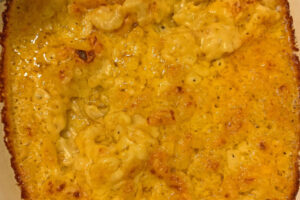Caponata is one of the most famous Sicilian dishes, often served as a vegetable antipasto or appetizer. There are 37 official recipes for the dish. For a history of caponata, click here. Mine features the essential eggplant, plus peppers, onions, celery, tomatoes, olives, and capers in a sweet-and-sour (agrodolce) sauce. Caponata benefits from being made ahead (at least 8 hours) to develop its full flavor.
I like to use 2 small very firm, deep-purple-skinned eggplants (about 1.5 pounds) in my caponata because they have far fewer seeds

Small, firm eggplants.
Wash, dry, and cut the eggplants (unpeeled) into small cubes. In a large heavy pot, heat 1⁄4 cup of the olive oil over moderately high heat and fry the eggplant cubes until lightly browned.

Fry the eggplant cubes.
You will have to do this in batches because you don’t want to crowd the cubes or they won’t brown. You’ll probably need to add extra olive oil between batches. Remove the eggplant cubes to a large bowl.
Dice the celery ribs and cook them in more oil in the same pot as you cooked the eggplant. Fry the celery for about 5-6 minutes just until lightly browned. Remove the celery to the bowl with the eggplant. Add the thyme leaves and season lightly with salt.
Cut the onions into very thin slices.

Thinly slice onions.
Cook them in the same pot over low heat, adding extra olive oil as needed, until translucent and softened. Cut the red peppers into small dice and add them to the cooking onions.

Fry the onions and pepper.
Add a pinch of salt, cover the pot and cook for about 5 minutes. You want the celery and the red peppers to have a bit of crunch to them. Mince the garlic cloves, uncover the pot, add the garlic stirring for about 2 minutes, being careful not to let the garlic burn. Many like to thinly slice the garlic cloves. I prefer to mince them because I don’t want a mouthful of garlic.
In a separate bowl, break up the tomatoes with your hands, a knife, or a potato masher.

Crush the tomatoes.
Return the eggplant and the celery to the cooking pot, and add the crushed tomatoes, plus all the tomato juice from the can.
Make an herb bouquet of several parsley, thyme, fresh oregano sprigs and any available celery leaves, tied together with kitchen twine.

Make an herb bouquet.
Add the herb bouquet and any remaining olive oil to the cooking pot, cover, and simmer the mixture for about 20 minutes or longer, stirring frequently until the mixture becomes rather soft.
In a small bowl, beat together the vinegar and the sugar until it’s dissolved.

Mix vinegar and sugar.
Add this, along with the tomato paste, the olives, and the drained rinsed capers to the vegetable mixture. Some recipes blanch the olives to remove some of the saltiness. I find this unnecessary.

Add olives and capers.
Stir to be sure the tomato paste is well distributed, and continue to cook for a few minutes until the flavors are well blended. Remove the herb bouquet, and taste for salt and pepper.

Simmer to jam-like consistency.
You may wish to adjust the amount of vinegar and sugar to your taste.
Serve the caponata warm or at room temperature, but never chilled. Though it can be served on its own, I prefer to serve it over grilled slices of crusty peasant bread that have been brushed with olive oil. I do this in a broiler.

Any remaining caponata can be refrigerated and gently rewarmed for future serving.




